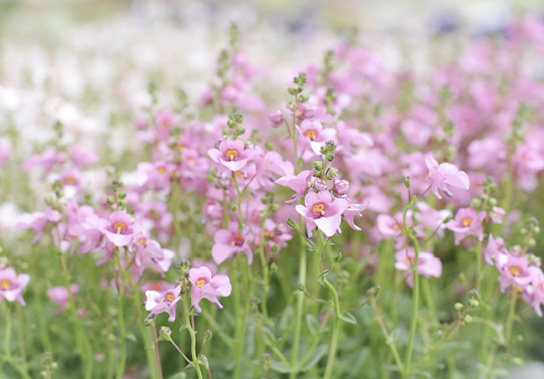Cool-Season Bedding Plants for Central Mississippi
Spring is the busiest and most popular time for garden centers to sell the bulk of their plant material, but this isn’t the only time to purchase and enjoy annuals that perform best in cool weather. Visit your local garden center regularly throughout the year to find a broader diversity of plant material. Fall is a great time to plant many trees, shrubs, perennials, and cool-season bedding plants. Many nurseries bring in fresh plant material in early fall that is healthy, fully established in the pot, and ready to be planted.
Many gardeners know there are cool-season and warm-season vegetables. For example, lettuce, spinach, and broccoli are cool-season crops, while tomatoes, peppers, and okra are warm-season crops. Likewise, there are cool-season and warm-season bedding plants. Some common warm-season bedding plants are marigolds, vinca, celosia, and gomphrena. These flowers grow well in the intense Mississippi heat. In contrast, verbena, petunia, alyssum, and pansies thrive in cool weather.
Care
Cool-season flowers planted in the fall will not reach their full potential without adequate care. Here are some tips for successful fall cool-season bedding plantings:
- Cool-season bedding plants need adequate water. Mississippi’s fall weather can be dry, so be sure to water as needed until the roots are well-established.
- Tightly-bound roots surrounding the outside of the root ball, often called circling roots, should be cut off, scored with a knife, or broken apart manually; this will help them get established in the surrounding soil.
- Plant cool-weather crops where they will get afternoon shade to extend their longevity in the late spring and early summer; too much shade will reduce overall flowering. It is also important to plant them in areas that have good drainage.
- Apply fertilizer based on the recommendations from a soil test. However, do not apply fertilizer after the plants have gone dormant and are not actively growing. Doing so will prevent nutrients from leaching through the soil. When plants resume growth in the spring, you can apply fertilizer again as needed.
- Plants may suffer winter damage. Remove plant tissue that is dead, diseased, or damaged. Be careful not to remove plant tissue that is just dormant for the winter. If in doubt, leave the plants alone until growth emerges in the spring.
Sweet Alyssum (Lobularia maritima)
Alyssum is a fantastic annual for sustaining early-season pollinators. Farmers sometimes plant them to attract pollinators to their crops. They flower through the fall, survive through the winter, and bloom profusely the following spring. They have a pleasant fragrance, as well, but are so close to the ground that their fragrance may go unnoticed. They range from purple to white. Breeding work has resulted in the release of cultivars with larger, more abundant flowers. Be careful not to let them get too dry, especially during warm days.

Snapdragon (Antirrhinum)
These plants come in a variety of pink, white, yellow, red, and orange colors. They have a wide range in size. Some tall varieties can be grown as cut flowers, while others never become more than a foot tall. It is not surprising that so few snapdragons appear in Mississippi landscapes because they are so unassuming at the garden center. It is typical for them not to have a single open flower at the time of purchase. When planted in the fall, a few flowers will develop, but the real show happens during April when they grow into plants with brightly colored flowers that are displayed on top of the green foliage. Spent flower stalks can be deadheaded or left to seed down more snapdragons. With warmer temperatures, flowering slows down. At this point, remove them from the flowerbeds and replace them with warm-weather annuals. Sometimes snapdragons survive the summer and provide another flush of flowers that fall or the following spring.

Ornamental Kale (Brassica oleracea)
Ornamental kale has become increasingly more popular over the years. Many varieties are available, even some that are sold as cut flowers in bouquets. They typically develop creamy white, pink, or purple leaves in the center of the plant’s rosette, but small plants at the nursery lack colorful leaves, which develop as they mature. They will eventually flower the following spring. Often, ornamental kale is removed from the landscape before flowers develop. It is edible but may not be as palatable as other varieties of kale.
.jpg)

English Marigold (Calendula)
These plants are related to the daisy family. They provide a bright spot in the garden with their golden-yellow to orange flowers. New varieties bloom over a more extended period and have improved heat tolerance. They attract butterflies and have been reported to deter deer. Calendula officinalis has medicinal and culinary uses. For example, chefs sometimes add the flowers to salads.

Calibrachoa (Calibrachoa)
Although they are in a different genus, calibrachoa are similar to petunias with smaller flowers. Some tend to be more sensitive to soil pH and nutrients than petunias, but breeding work is improving their performance. They come in a variety of colors. Their growth habit is mounded and compact, making them an excellent choice for containers. They flower heavily in the fall and the spring.

Dianthus (Dianthus)
Several species from this genus are well established in the marketplace. One of the most popular is carnations, especially in the cut-flower industry. They range in size and in color from white to red to bicolor. Breeders have released many cultivars that are stunning in the landscape. The lifespan of these plants varies. Sometimes they are categorized as a biennial or short-lived perennial. While often sold as annuals in the spring or fall, they easily survive the winters here in Mississippi and erupt into a show of flowers in the spring.


Twinspur (Diascia)
These snapdragon relatives develop clusters of dime-sized flowers on short flower spikes. Colors include orange, red, salmon, pink, and white. Flowers can be so abundant that the leaves are not visible. They bloom in the fall as well as in late winter into early spring. Flowering wanes in the summer, and the plants can die out during that time. Cut back to remove spent flowers.

Foxglove (Digitalis purpurea)
This beautiful woodland plant is a star at the back of a lightly shaded flowerbed. Their flower spikes can grow up to 4 feet or more. The most common colors are pink, light purple, light yellow, and white. Because they tend to grow so tall, they can benefit from staking. These plants perform best when planted in an area with bright, but not direct, sunlight. Some varieties may last for several years as perennials, while others survive just a couple of years.

Wallflower (Erysimum)
This plant is in the mustard family, along with cabbage and broccoli. It has attractive flowers that are visited by a range of pollinators. They range in color from orange to red to purple. Most of them grow to be about 1 to 2 feet tall and wide, but size varies based on the variety and growing conditions. They are especially attractive when planted in large masses. Some varieties may survive for a few years, while others will not withstand the hot summer temperatures.

Coral bells (Heuchera)
Although these plants are typically perennial in central Mississippi, they are included in this publication because they are a fantastic cool-weather crop. Additionally, garden centers often carry these plants in the fall. They look great in both fall and spring and are evergreen to semi-evergreen. Breeders have developed cultivars with stunning flowers and leaves; however, some have attractive foliage with unattractive flowers. Be sure to remove them so that they will not detract from the colorful leaves. Additionally, remove all flower spikes after flowering. Check the plant tag for the optimal lighting conditions for that specific cultivar. Some cultivars can handle the intense full sun, while others require shade.


Stock (Matthiola incana)
These showstoppers form flower clusters similar to those of delphinium but have a pleasant, sweet fragrance. Flower colors include white, yellow, red, purple, pink, and magenta. Florists routinely use them in cut-flower arrangements. They do not perform well in hot weather, but they will flower nicely in the springtime.
Nemesia (Nemesia)
These plants are in the same family as twinspur and snapdragon, and their flowers have a miniature-snapdragon look to them. They look like twinspur in their growth habit; however, they tend to be more upright. They begin flowering in the fall and then bloom again in late winter and into the early spring. They come in a range of colors, including purple and bicolor. Some species of nemesia may not be cold-hardy enough to survive through winters in central Mississippi. Check the plant tag or ask a garden center associate about zone hardiness.


Petunia (Petunia)
Petunias are often not thought of as being able to withstand freezing temperatures, but many cultivars can. Hard freezes do cause damage, but they grow back quickly from the stems and will flower during Mississippi’s early spring. Many petunias will not survive through the intense heat of summer; for the earliest spring flowers, fresh petunias will need to be planted in the fall. Petunias are easy to grow and come in a rainbow of colors. Experiment with different cultivars to find ones that will survive through winter, such as Easy Wave Silver.

Verbena (Verbena)
There are many cultivars of verbena, but Homestead Purple is one of the most popular cultivars ever released. Other cultivars have showy colors, like bright red, white, purple, pink, and bicolor, and all of them do exceptionally well during the cool months. As the summer heat rises, flowering stops. During fall, they begin flowering again, and, by the following spring, the plants will be in full bloom. These can last for several years in the landscape, but many of them will not survive reliably year after year. Plants are typically less than a foot tall; some are even less than 6 inches tall. They spread out as a groundcover and fill in nicely around foundation plants.



Pansy, Violet, Viola, Johnny-jump-up (Viola tricolor)
These are some of the most popular purchases for fall gardening and are readily available at garden centers, hardware stores, and even grocery stores. They have a long horticultural history going back hundreds of years, yet they continue to be relevant in today’s marketplace. They bloom throughout the winter; however, flower production increases substantially after hard freezes end in the spring. They come in a variety of colors and are relatively easy to grow. Some have nicely fragrant, edible flowers that restaurants sometimes serve on gourmet salads. They benefit significantly from early-spring fertilizing. As temperatures rise, the plants stretch and turn yellow, and flowers shrink in size and production slows down. Pansies (Viola tricolor var. hortensis) typically have much larger flowers than the unhybridized species. Plant them above spring-blooming bulbs such as daffodils to create a beautiful spring flowerbed.


Publication 3370 (POD-08-22)
By Shaun Broderick, PhD, Associate Extension/Research Professor, Truck Crops Branch Experiment Station.
The Mississippi State University Extension Service is working to ensure all web content is accessible to all users. If you need assistance accessing any of our content, please email the webteam or call 662-325-2262.






